MusicMaster Blog
Maximum Rest vs Absolute Maximum Rest Publicado por Laurie Knapp en enero 22nd, 2024
by Paul Ziino
There are lots of rules available in your Rule Tree. I see these two used frequently, but they are often misunderstood.

First, what does Maximum Rest do? When you place Max Rest in your active Rule Tree, it acts as a turnoff point. Once the time has been met as set in your Max Rest rule, any rules that come after it are turned off, thus making the song a priority for scheduling. Here’s my rule list for category H-Hot Recurrents.

Max Rest is set to 1d 13:00. Once a song has rested longer than 1d 13:00, Maximum Rest will turn off the rules that follow. Basically, once a song has rested 1d 13:01, we no longer will test the Tempo rules in this example. You will see this in the Schedule Editor represented by rules that are listed in black—black rules are not being tested. (The two rule groups that appear in black do so because they have time restrictions and are not being tested at this point in the schedule.)

Notice I said Maximum Rest turns off the rules that come after it. Maximum Rest does not turn off Optimum Scheduling Goals. So if the Goals are in place, they will still play a part in the automatic scheduling process.
But there is another rule option available if you really want to ensure the song plays, no matter what. If Absolute Maximum Rest is exceeded, the song is immediately scheduled right then and there without regard to any existing rule failures or Optimum Goals.

To summarize, Maximum Rest will turn off the rules that come after it, while Absolute Maximum Rest turns off the rules and the goals that come after it in the rule hierarchy.
As always, if you have questions on this or any other MusicMaster related topic, don’t hesitate to reach out to our support team. We’re happy to assist!
No More Forgetting to Make a Backup! Publicado por Laurie Knapp en diciembre 19th, 2023
by Vicky James
Over the years, I’m sure you’ve heard your MSC remind you of the importance of backing up your database.
First things first… What is a backup? A backup saves all the hard work in which you’ve spent years, days and countless hours building your MusicMaster database. It breaks my heart when a station is attacked by ransomware, which is becoming more and more common, and that hard work is LOST. Let’s not even talk about the unthinkable… when a scheduling computer decides to kick the bucket and with a recent backup, that MusicMaster data dies right along with it!
The good news is, we’ve released a few new tools in MusicMaster Pro that make backups even more convenient for you!
With the release of MusicMaster Pro 8.0.9, you now have Backup OPTIONS! Backup Options allow you not only to set a reminder but also gives you the option to make a backup at that very moment when prompted.
Here’s a brief refresher on how to make a backup, and more importantly a guide leading you in setting the new Backup options.
Under the Tools menu, the first option is Backup.

Once the Backup window is open, you’ll see that MusicMaster tells you when the last backup was performed. As for the types of backups, Standard and Custom, you can read more about them here: https://musicmaster.com/?p=43

But in MusicMaster Version 8.0.9 or later, the new OPTIONS button is what the hype is about!! Click it and you’ll see the following:

This new MusicMaster feature Backup options has to ways to remind you of taking a backup!
The first option is a reminder displayed in the Title Bar display, so you can always see the date/time of the last backup while you’re working in the database.
Here’s how the title bar appears when you select that setting in Backup options.

The next Backup option prompts you to create a backup upon closing the database.
You have the option to specify the number of days to request a backup from the last one taken. This value can be set to 0 prompting you every time you close the station database, or you may increase the number or days. In the example shown above, MusicMaster will now ask me if I would like to make a backup if it’s been at least 3 days since the last backup was made.
When closing the database, this prompt below appears showing me the last backup and asking if I would like make a backup now.

But wait, there’s more!
In the service release of 8.0.12 for MusicMaster Pro, you also have options to save copies of your backups in more locations!
Since joining MusicMaster, I can’t tell you how many times I’ve heard the statement, “I don’t know where MusicMaster backups go!!!” This is often in response to me asking, “Do you happen to know the location of the backup we’ve made?” or “When was your last backup?”
Team MusicMaster has now expanded the CUSTOM BACKUP feature allowing you to save it in up to not one, not two, but three locations! This is especially helpful if you want to store a copy in another location for safety (such as Dropbox or an external thumb drive). Or maybe you want to send a second copy somewhere you can easily find the file and send it to your consultant.
Here’s the beauty:
Go to Tools menu, Backup. Click Create for a new Profile or Modify a current profile.
Enter the location for the alternate backups here. I’ve created two additional copies of backups on both my External drive and Dropbox folder.

Once the locations are set in the profile, click OK. Next, you can then Perform a Custom Backup to be saved safely in each location.
If you have more questions about these new Backup options, contact your Music Scheduling Consultant directly to help!
From Rock to Jock; Musicians in Radio Publicado por Laurie Knapp en diciembre 11th, 2023
by Brian Wheeler
Passion. It’s a common thread among broadcasters and musicians. You need passion to get into and stay in both industries. Passion is what drives and fuels us. For that reason alone, radio and musicians are a solid match. While not every musician has the chops to make interesting radio, there are at least a few artists I’ve found that have hit the airwaves and are carving a niche for themselves in the broadcast world. To get a glimpse of radio from their perspective, I caught up with Brian Vander Ark of The Verve Pipe and Ron Keel of the bands Keel and Ron Keel Band. I would be remiss to not include Steve Gorman, formerly of The Black Crowes and currently doing mornings on KQRS in the Twin Cities, but he politely declined to participate.
Brian Vander Ark recently signed on with WLAV-FM in Grand Rapids, Michigan as their afternoon drive host. It’s a sort of homecoming for him, as he grew up in western Michigan. Along with appearing on podcasts, Brian’s also had a YouTube channel for several years.

Ron Keel launched his syndicated radio program called Streets of Rock N Roll in 2012. In 2014, Ron signed on as the midday host at KBAD-FM in Sioux Falls, South Dakota. KBAD folded in 2017 despite solid ratings, but Ron’s syndicated program marched on. In 2022, Ron launched RFK Media LLC and continues to broadcast on that platform.
I asked Brian and Ron to tell us a little bit about their respective stations and how their initial interest in broadcasting came about.
BVA: I was approached by Michelle (McKormick) and Gregg (Henson) about the possibility of doing a show – I jumped at the chance.
RK: KRFK is a hard rock and heavy metal streaming station administered by my company RFK Media. It is not a hobby station; although I love what we do this is still a business, so it’s built to succeed and deliver an entertaining listening experience for people who love this kind of music. The playlist is as diverse as they come, featuring all genres and eras, the legends, the rising rockers, and some of the artists and songs that may have fallen through the cracks over the years.
While the meat of the sandwich is the music, we’re also proud to host the best syndicated shows in the business – headliners like Eddie Trunk, Charlie Kendall’s METALSHOP, Dee Snider, Joe Elliott from Def Leppard, and many more throughout the week.
My interest in broadcasting stems from hosting my own weekly syndicated show, STREETS OF ROCK N ROLL, since 2012. I graduated to hosting the midday show on KBAD 94.5 FM in my adopted town of Sioux Falls, and learned so much from the rock radio royalty that surrounded me.
How has the audience responded to your show?
BVA: The response has been very positive, which is inspiring. I think once I get my footing and start choosing more of the playlist, everyone will enjoy it even more.
RK: My show STREETS OF ROCK N ROLL is an acquired taste – it’s not for everyone, and I’m cool with that. That’s my hour to create the kind of show that I would personally enjoy; always built around strong feature interviews with rock stars and other celebrities, and usually about 90% new classic rock. Some people just want to listen to “You Shook Me All Night Long” and “Pour Some Sugar On Me,” but as a fan I’m still excited to discover new music and share it with my friends, and that’s what we do on the STREETS OF ROCK N ROLL.
What drew you to radio/broadcasting?
BVA: Nothing specific, although I wear my love of classic rock on my sleeve for sure.
RK: I’m an entertainer by nature, a storyteller, a musical artist. Radio is another outlet for me to entertain people. The inspiration to dive in came from friends and heroes like Kevin DuBrow, Dee Snider, and Alice Cooper who paved the way with their radio shows; you hear these guys having fun, you want to host your own party. So in 2012, while performing on the legendary Monsters Of Rock Cruise with dozens of other rock artists and bands, I just wandered all over the ship with my portable recorder getting quotes and soundbites from all the rock stars and the fans, edited all that together with the music from those artists and some commentary, and all of a sudden the STREETS OF ROCK N ROLL was in high gear.
Can you share some memories of listening to the radio, both growing up and later while in the music industry?
BVA: Absolutely. WTAC in Clio (Flint) had a huge influence on me – I used to let the AM station play all night when I was a kid— many of the songs incorporated themselves into my dreams.
RK: The common story about being a kid in the 70’s, and that first little AM transistor radio was like a bridge to another world – turning the dial and exploring all the different styles of music, from stations in faraway exotic places like Chicago! I would sleep with it under my pillow all night long.
Then of course there’s no thrill like hearing your own music on the radio for the first time, every artist remembers that.
As I really began to mature as a songwriter, my head started filling up with my own songs, and listening to other music becomes a distraction. It’s still that way now, as I have a half dozen songs spinning in my brain at any given time. So I gravitate to talk radio – sports, politics, public broadcasting and especially Coast To Coast AM, the iconic late-night paranormal show. I listen to that type of programming when I’m in a creative phase, and then when I’m creatively exhausted, I’ll binge-listen to music for weeks. That’s why I usually take a break from hosting my radio show a few weeks every year to focus on songwriting.
As a successful musician, you enjoy a unique perspective when it comes to your on-air product. You’ve been on the music side of the product and the mic side. How does this play into your role and personality on the station?
BVA: I’ve always had a sarcastic or sardonic approach to talking about the things I love. Having a sense of humor towards music and the industry has been an important element- it kept me sane through all of those years. So my approach with the show is very much the same. People will either get it or they won’t, but I’m guessing they will and we will be able to build a massive audience.
RK: At first, the rock star thing was both a detriment and a benefit; there’s always been a comfort factor between me and the artists I interviewed, because we could relate to each other. There’s always a lot of common ground. But when I first started, the performer in me was trying to “put on a show” – in my business it’s always New Year’s Eve, the 4th of July, Halloween, everything’s overdone. But I found that the working class, which is really my audience, were just regular people trying to make it through another day. I learned two invaluable lessons doing live radio on KBAD for two years: one, just be yourself, and two, you’re not trying to entertain a million people – you’re just spending the day with that one person out there listening on the job.
In your opinion, what makes ‘good radio’?
BVA: Good radio is a host that can usher you from one song to another with ease. Genres are crossed, and it all makes sense with the on-air personality being the common thread.
RK: That’s a great question, because the medium has evolved due to the streaming revolution and the decrease in full time disc jockeys. Rock n roll is especially meant to be a shared experience – not a solitary listener with a curated playlist. It should be live, dangerous, unpredictable, fun, and interesting. Most of the shows on KRFK are pre-recorded and syndicated, but the hosts are fans first and that tangible human excitement is something you can’t get from Spotify or YouTube Music. Good radio must have an identity, a sense of community; no matter if you’re broadcasting from a tower or streaming online, you gotta treat those listeners like family, not like customers.
As a singer/songwriter, you can relate and tell stories which potentially lends itself to interesting on-air content. What advice would you give other musicians about considering an on-air role as a radio personality?
BVA: Be honest. Be forthright. Don’t hold back. Get into trouble on occasion.
RK: The same advice my mentors gave me – just be yourself. And always remember you’re not talking to a million people, you’re talking to that one guy on a construction site, or that girl at the office with her earbuds in, or that trucker who’s just trying to stay awake. You’re not trying to hold a sold-out arena in the palm of your hand. It’s really cool that at any given point, I’ve got 25,000 people tuned in, but if I think about it that way I’ll start “acting” and radio listeners don’t relate to that.
What would you tell radio stations that might reach out to an artist for a potential on-air position?
BVA: I’ll wait for the ratings to come in before I comment 😉
RK: I would tell them to reach out to me at RonKeel.com, because I have twelve years of experience on the air, and my show is available for syndication – let’s take your listeners on a ride down the STREETS OF ROCK N ROLL!
Anything else you’d like to add?
BVA: Nothing really! Thanks, dude!
RK: Well, I want to thank you for the opportunity to share some thoughts and feelings on radio, a topic that I’m obviously passionate about. I owe a huge debt to friends in the industry who have helped steer me in the right directions and taught me so many valuable lessons; I like to think I have a nice balance between being able to listen and learn while still doing things my way, and the proof is streaming right now at http://KRFKradio.com.
A big THANK YOU to Brian Vander Ark and Ron Keel for taking the time to participate and share their thoughts.
Take Shortcuts! Publicado por Laurie Knapp en noviembre 29th, 2023
by Chris Hulsether
If you like to use your keyboard to hit a button or two and get where you want to go, you’re in luck! MusicMaster has all sorts of ways to help you whip through your database quickly and efficiently using your keyboard.
In this article, I will go over the many ways to use keyboard shortcuts. We have basic default keyboard shortcuts that can be used in your Library Maintenance, Schedule Editor, and more. Also, I’ll show you how to turn on and use our Hotkey Emulator, which will bring shortcuts you may have used before with other music scheduling systems. We also have a way to add your own customized hotkeys.
MusicMaster Shortcuts
For reference, you can print off the list of all the shortcuts we have in the software. Go to Help/Index and search “Shortcuts”.


Then click Print and print to paper or PDF and save it where you want.

Here are some helpful shortcuts you can use in Library Maintenance:
For example, you can hit F6 to view your History Graph and review how a song has scheduled throughout the weeks. When you need more room to review other songs in your library, hit F6 again and the graph closes.
F7 allows you to Mark a song. Typically, it’s marked in powder blue. You can mark songs for reference or use this to perform batch operations on all marked songs. If you right-click on your library grid to open the context menu, you’ll see options available for marked songs, such as Move, Copy, Delete, Merge, and Print.

Hit ALT+ F7 and the marking song utilities will open.

If you have a bunch of marked songs, SHIFT+F7 will jump to the next marked song.
You can also open the library query window with CTRL+Q to search your library for specific things. Whatever field you are in when you hit CTRL+Q will become the search filter. For example, if you are in your Artist Keyword column and hit CTRL+Q on a song, the query window will already be set to search Artist Keywords.

Heading over to the Rule Tree, you can use CTRL+W to open the Rule Tree Wizard and see recommendations for changes. (Learn about the Rule Tree Wizard here).

In the Schedule Editor, you can use F5 on two songs to swap them. Select the first song you want to move, hit F5, and you will see a red mark on the left side. Then select the other song you want to swap with and hit F5 again. The two songs will swap positions.

If you want to have more space to see your log and you have the History Graph and InfoBar open, you can toggle them on and off with F6 for the History Graph and F11 for the InfoBar.


If you have rule failures or unscheduled positions as a result, you can use shortcuts to jump to each so you can replace the song. Hit CTRL+N to go to the next rule failure and Ctrl+P to go back to the previous rule failure.
HotKey Emulator
How about those Hotkeys you used to use in other software and still have the muscle memory for?
Go to Tools/Options/Additional Options:

Change Hotkey Emulation to a 1 and these shortcuts will be turned on.
These hot keys will work on any non-editable field in the Editor. It changes nothing when you are in an editable field like Artist or Title. These functions are available:
1 – Search for songs where the Auto Match field matches the current song
2 – Search for songs where the Auto Match field matches the previous song
4 – Open the Vicinity Viewer
A – This requires the Additional Properties, AutoMatchField to be set to the Field ID of the keyword you wish to use. With the history graph then open, pressing “A” will change the graph to show the keyword display.
G – Select a song from a saved song list, where it first opens a box allowing you to select a saved list.
J – Swap songs
K – Load songs from the category of the current song into the replacement song window
O – Undo
Q – The Q Filter pops up a list of song attribute codes to search for
S – Schedule from selected category where a pop up lists the categories and the songs from that category
U – Unschedule the active element
X – Toggle the Element Mask to show/hide music and non-music elements
Y – Opens the Yesterday Window (the MusicMaster Schedule Review showing the log from the previous day)
Custom Key Mapping
This is where you can add some customization to your Shortcuts. It’s available both in the Library and Schedule Editor.
Let’s look at how to set this up in Library. Open your Library Maintenance, then go to the menu bar and click on Library > Key Mapping.

Now, you can add shortcut keystrokes to use while you go through your library.
Select the key you want. I selected ALT+1 for layout editor. This allows me to pull up the grid layout editor and add/remove things from my library grid. You can set one for saving your changes or loading a different layout.

You can do the same to bring up things like the Attribute editor, Keyword editor, the Mass Changer and many other tools.
In the Schedule Editor, you can do the same. Shortcut options include various audio playback controls, replacement song functions, history snapshots, publishing to automation, navigating within your logs, toggling between layouts, and so much more!

Today more than ever, you need ways to take a shortcut and get more out of your database in less time. Contact your Music Scheduling Consultant for assistance.
Every Picture(disc) Tells a Story Publicado por Laurie Knapp en noviembre 13th, 2023
by Brian Wheeler
I recently embarked on a little adventure that may very well prove my insanity. After a friend told me of a large music collection sitting in a storage unit in south central Texas, I flew down and obtained a good portion of the collection. The cache was large enough to require the assistance of a good friend of mine, and you know they’re a good friend when they agree to hop on a plane with a few days’ notice to load a music collection into a moving van in 109-degree heat, then trek 1200 miles in 24 hours to get it safely home. For the sake of space and time, I’ve substantially condensed the portion of the story where we moved the collection. The journey fell short of Clark Griswold proportions, but it had its share of excitement.

A good music collection often speaks to the collector’s personality: the stories that have touched them, the life they’ve lived, the causes they’ve championed, the cultures in which they’ve immersed themselves. It’s usually a rich tapestry of the collector’s past. Music collections can be intimately vocal declarations of your life. For those whose lives are surrounded by music, their collections have checkpoints and pathways that reflect their life’s journey.

For example, I’ve caught glimpses of MusicMaster founder Joe Knapp’s collection. As you can imagine, it was vast and far-reaching. Did you know Joe is an unapologetic champion of garage rock? I fondly recall a conversation about a 45 record that my mother owned, a very regional single in the 60’s from The Defiants called “Bye Bye Johnny”, with the B side being a cover you may recognize: Bob Dylan’s “Maggie’s Farm”. As a child playing with my mom’s records (she supported my record spinning very early in life) I was drawn to the B-side almost instantly, but I had no idea that it was a Dylan tune until I’d heard his version a few years later. “Maggie’s Farm” is credited to ‘Bob Ryland’ on the Defiants record, hampering my eventual discovery.
Fast forward decades later, and my collection has grown and blossomed into a patchwork of snapshots in time, with musical threads that often run through a good portion of my life. I could probably tell you a story about 90% of my personal library if you were so inclined to listen. This is what makes the collection I’ve recently obtained so fascinating. Sadly, the prior owner of this collection is now deceased, having only lived until his mid-50s. The collection he left behind speaks of a life richly lived. There are signed records, CDs, and photos littered throughout the collection. He wrote to some of his favorite artists and they responded, often gushing about his writing prowess. Like Joe, he also loved garage rock as his collection is peppered with examples across the decades. He loved rockabilly, blues, punk, red dirt, Tejano, Surf, jazz, zydeco, and a wide variety of other music. I was impressed with his musical vision, having booked The Screaming Trees to a small club show in 1987 and bringing a band called Soundgarden to a tiny area club in 1989. He supported a wide variety of female artists in many genres, with a solid sampling of strong female voices throughout the collection. This gentleman also was a champion of the underdog and of the fallen. He was involved with fundraisers for musicians stricken with hard times. Upon researching a small stack of CDs within the collection, I learned that the former collection owner had created a Kickstarter campaign for a local musician that had passed away under mysterious circumstances, successfully backing the creation of a memorial CD to keep his memory alive. He did this all while dealing with serious health issues of his own, health issues that would eventually claim his life as well.
A personal music collection has soul. It has substance. It tells a story. The music contained within has its own stories, each told within its own context and language. It’s the stuff of life. From cavemen writing on walls to middle-aged guys writing blogs to kids starting their own podcast, I believe it’s part of the human condition for people to want to tell their stories. The urge to be heard and understood will never change. For those who love music, their collection is an extension of their identity. That’s why I believe that as long as there is music, there will be collections. I personally still believe in the power and value of tangible media. Of course, there are certainly many advantages to digital media, and most MusicMaster users know that their digital library is their lifeblood. But I still see substantial value in picking up a record or a CD and enjoying the presentation and feel of tangible media. Vinyl has enjoyed a huge resurgence and strangely, so has cassette and even 8 track tapes! I also think the CD renaissance is just around the corner. If you’re looking for me, I’ll be in my basement spending time with some recent arrivals.

MusicMaster Pro 8.0.12 Publicado por Scott Wirt en octubre 31st, 2023
MusicMaster Pro 8.0.12 is now available via Help, Check for Update. Here are some highlights from this release:
You can now program a custom backup profile to make additional copies of your backup file in up to three alternate locations.
The Library Search Bar will now use the default Library Maintenance sort key if it has been set.
New options for the MinMax Step Rules allow you to set the rule so the range is allowed in only one direction, and any transition in the opposite direction will count as a failure.
Reworked the metadata download in the CD Ripper to improve reliability.
You can find the full list of changes under Help, Release notes. Contact your MusicMaster Scheduling Consultant with any questions.
“U Got the Look” Customizing MusicMaster Publicado por Laurie Knapp en octubre 27th, 2023
By Dave Tyler
I am sure you’ve noticed that just about everything these days is customizable to your preferences. MusicMaster is no different. Some of us spend many hours a week in front of our computers using MusicMaster, so wouldn’t it be great if you could make it look just how you wan it to? Well…YOU CAN!
Of course you can color and style your categories by going to Dataset/Library/Categories and then choosing the Properties button.
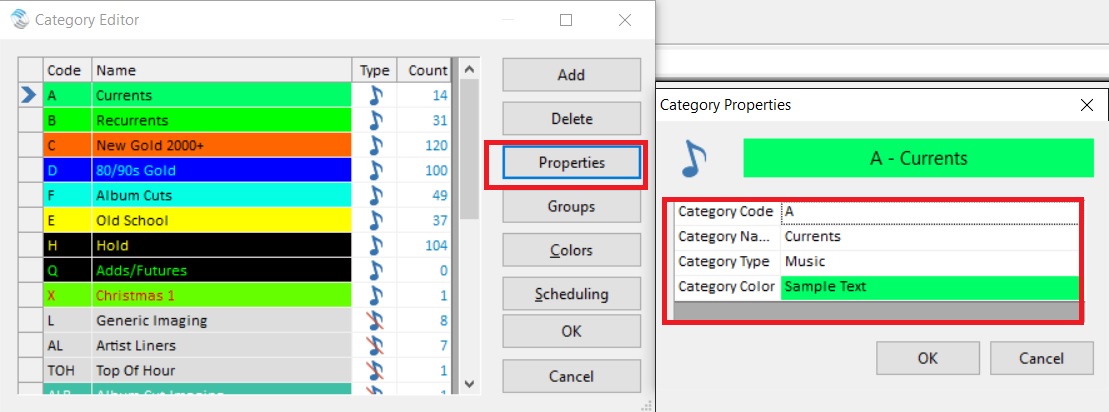
You can even add your favorite picture or station logo to the background of the main window by going to Tools/Options/Dataset Identification.
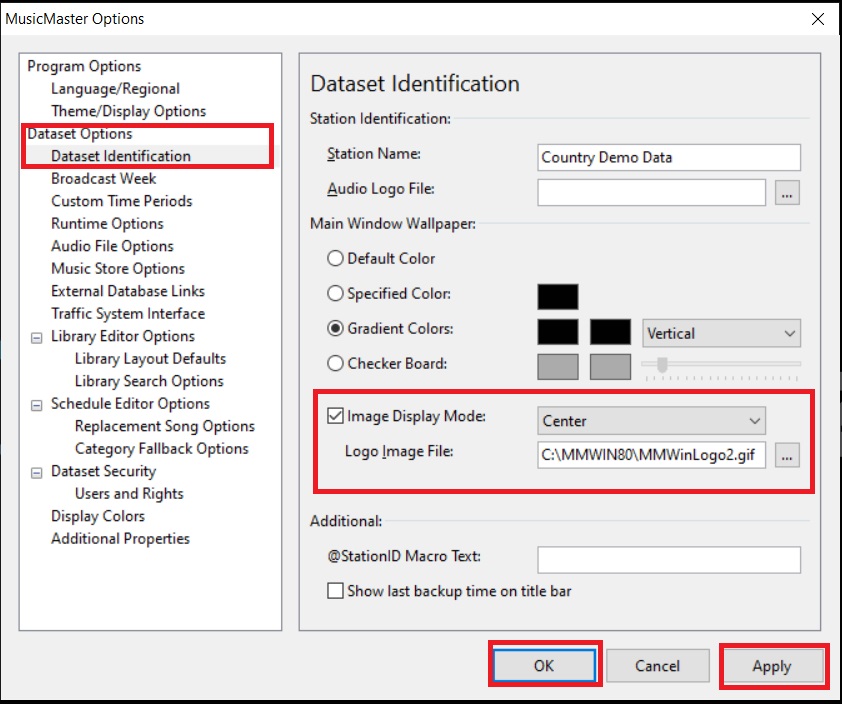
And just like that my sweet looking logo is right there!
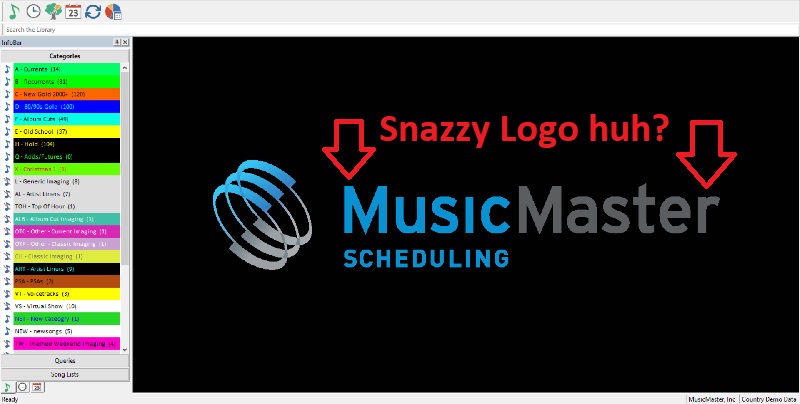
But wait, there is even more ability to customize in the Tools/Options area. See where it says Theme/Display Options? That’s the spot.
The title of this blog was inspired by the Prince song of the same name, so let’s dig in to some of the cool premade themes the MusicMaster team already has ready for you to use. Let’s start with “Purple Rain”….pretty cool don’t ya think?
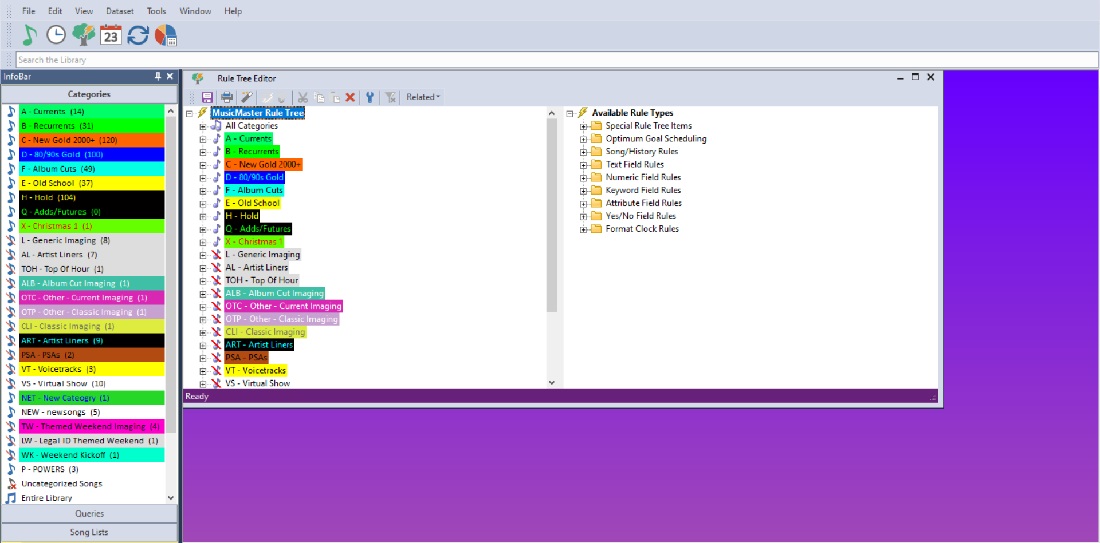
I think it is pretty cool that there are several premade themes for you here to explore and play with.
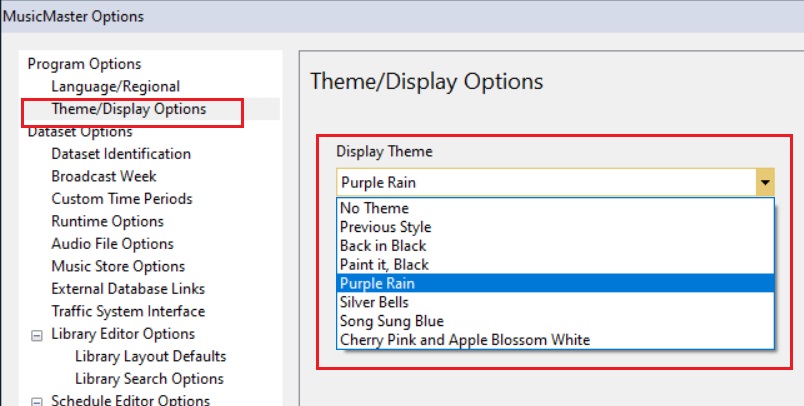
For those of us that like simple, then you can choose No Theme. Or if you recently updated to version 8 from let’s say version 6 you might prefer the old style of icons you had in 6. Selecting “Previous Style” will get it back to that look for you.
We’re in radio…. This is supposed to be fun right? I love it when I am helping a client and I see that they have totally made the program to look the way they want to see it. I have seen some crazy color schemes, etc. We spend a great part of our lives working and cultivating the sounds of our radio stations. Enjoy it….your way!
Export & Import Your Clocks! Publicado por Laurie Knapp en octubre 2nd, 2023
by Vicky James
Last time we connected I shared with you a How-To on cleaning up your clocks. Well, this time around I wanted to take that discussion a bit further. I had a client reach out because he was working on creating a new HOT AC format but was totally bummed…. Why? This guy absolutely loved the clocks that he’d created from his Mainstream Station, which included the lognotes and traffic breaks that would be literally the same in the new station with only a few modifications.
There were a couple of ways that he could’ve done this. Had he cloned the old database and wiped it clean, all of the work he’d done in the new database would essentially be lost. So I suggested he use the Export and Import Clocks feature, which was totally unbeknownst to him, and we were able to save his work!
Let’s navigate to the Clock icon in the toolbar, which opens the Format Clock Maintenance panel.

Here you will select the clocks that you want to export.

Set the destination to Save the exported clocks to.

Once they are saved, the number of clocks exported will confirm.
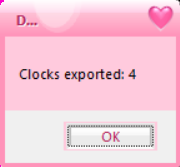
Now let’s open the database that you would like to Import the Clocks into.
Once open, let’s go back to the Clock icon to again open up Format Clock Maintenance.
This time, click Import.

Now, you will click on the gray icon to navigate to the location of the saved  Exported Clocks.
Exported Clocks.
In this case, I assigned a New Unused Clock Code since I didn’t have any clocks in this database yet, but you can also overwrite existing clock codes if you want.
Once you select OK, the clocks will be imported into the database as seen in the image below, and you can move forward in making the modifications needed to the clocks.

If you have any further questions about how to Export or Import Clocks in MusicMaster, contact your Music Scheduling Consultant for more in-depth guidance!
A Shift in Listening Requires a Shift in Thinking Publicado por Laurie Knapp en septiembre 27th, 2023
by Brian Wheeler
There are a good number of ways to manage rotations in MusicMaster. Hour rotation rules are a powerful tool to correct wayward rotations of a category. One such rule is the Shift Rotation rule. The concept is fairly straightforward. You can define the shifts your station employs, then ask MusicMaster to encourage the songs that are scheduled to find different shifts when scheduling. But is this concept outdated?
I discussed this very topic with our own Founder and President, Joe Knapp. He originally broached the subject in a conversation regarding rotations in general. We both agreed that ‘destination listening’ seems to be a rare thing these days. Listener habits are simply not that regimented anymore, and if they are, it’s more than likely going to be due to listeners tuning in for a talk format. There are exceptions to this of course. But even if you do have jocks that warrant shift rotation rules to protect rotations, it’s important to be aware of the limitations of a shift rotation rule.
Let’s take a look at a typical shift rotation grid. To use a shift rotation rule in its pure form, you must first establish your shifts. A typical setup may look like this:

In this case, overnight is shift 1, mornings are shift 2, middays are shift 3, etc. Once the shifts are established, you can now ask MusicMaster to ensure that songs that play in one shift do not return to said shift until that song has been scheduled in X other shifts. Pretty simple stuff, right? But what if a particular song plays at 2:57pm, then plays at 3:08p the next time it plays? As far as the shift rotation rule is concerned, this is a perfectly legal move. This is why one must not use shift rotation as your sole source of rotation protection. It’s a fine start, but it shouldn’t be the only hour rotation rule you use if you’re using hour rotation rules at all.
Since we’ve arrived at the notion that most listeners aren’t destination listeners, is the shift rotation rule a tool of the past? Not necessarily. You can also use the shift rotation rule to protect regions of the day. The shift rotation rule doesn’t necessarily have to mirror your actual shifts. You can set up your shift assignment grid to simply reflect 3-hour windows of time, for example. See below:

In this setup, we’ve regionalized the day without necessarily defining actual on-air shifts. The purpose of this would be to keep the songs moving into different areas of the day without specifically confining the songs to proper shifts. Note the overlap of 11p into the first two hours of the ‘overnight’.
Here’s another grid that I’ve employed at stations I’ve programmed. This grid is a bit of a hybrid of the actual shift rotation grid, but I’ve created a shift for drive time. The idea is to mainly protect the drive times in the morning and evening. If I’ve played a song in EITHER the morning or afternoon drive, I want the song to play in X other regions before it returns to drive time.

It’s important to mention that these rules are quite effective when set up mindfully. You’ll not want to apply a shift rotation rule to a category that is only used in limited hours, for example. Doing so can choke out a category and cause MusicMaster to no longer be able to schedule them. For this reason, it’s suggested that these and any other hour rotation rules are applied on a category-by-category basis, or perhaps using a rule group to isolate specific categories that must adhere to the hour rotation rules. I also recommend setting a Max Days setting on these rules, which essentially ‘lets MusicMaster off the hook’ by establishing a day in which the rule no longer has to be enforced. Let’s face it, sometimes there’s an expiration on rules, as many days have rolled by and the importance of advancing the song into a different shift takes a back seat to getting the song played again.
In most cases, my recommendation is to set individual hour rotation rules for each category as one size rarely fits all. As always, if you have questions regarding shift rotations or any other hour rotation rule, reach out to your Music Scheduling Consultant here at MusicMaster!
A New Way to Sort Your Library Publicado por Laurie Knapp en septiembre 21st, 2023
by Paul Ziino
Starting in MusicMaster Pro 8.0.11, you can change the default sort order of your library when you open categories via the Info Bar. By default, MusicMaster’s library sorts by Song ID, the internal number that keeps track of your songs. Song ID started at 1 with the first song added. The second song added was 2, and so on. Once a song is deleted, its Song ID is never repeated in the library.
With this new feature, you can change that default sort order. If you’d rather your library opens alphabetically by Artist or by Title, you can make that adjustment. Go to Tools/Options and under Library Editor Options you’ll find Library Layout Defaults. Here you can pick a different field (instead of Song ID) for the Library Maintenance Default Sort Field.

If you leave the setting at [None] there will be no change. But if you change it to Artist, now when you double-click a category from the Info Bar list, that category will open sorted as you’ve indicated. Maybe you want the library to sort by Title? Or what about by your automation asset code? Or any other field in your data. Whatever you desire, you can set it.
For assistance with this or any other MusicMaster items, call or email your MusicMaster Scheduling Consultant today.


